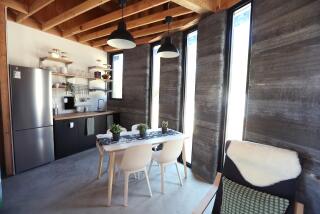Foam-Block Homes Offer Excellent Insulation
QUESTION: I am on a limited budget and I am interested in building one of those do-it-yourself insulated foam block/concrete houses. How energy-efficient are they and are they easy and inexpensive to build?
ANSWER: The new types of foam block/concrete houses are extremely energy-efficient, especially for air conditioning. They are very well-insulated with minimal air leakage and look like any conventionally-built house. The first manufacturers were located in California.
These houses are basically made of hollow insulating polystyrene foam blocks that fit together to become the concrete forms. Each foam block is roughly 10 inches square by 40 inches long and weighs only 1 1/2 pounds. The blocks for an entire house weigh only several hundred pounds.
Once the blocks are in place, creating the foundation or walls, concrete is poured into the hollow openings from the top. This forms an extremely strong, monolithic-insulated concrete structure. The foam sections of the blocks on the inside and outside provide an insulation value of R-20. That is more than most conventional studded and insulated walls.
In addition to the low-energy usage, the strength and termite resistance, these houses are very quiet. The combination of the heavy concrete mass and the foam on both sides stops much of the outdoor noise.
The concrete inside the walls also acts as a thermal mass to reduce the temperature swings inside the house throughout the day. That reduces the overall energy usage and increases your comfort level.
It is easy to build one of these houses yourself and greatly reduce the building costs. The blocks are made to snap together like a huge Lego set so you can build up the entire wall yourself. Then, with a small saw, cut out the openings in the foam blocks for the windows and doors.
Once everything is ready, just have the concrete poured into the top openings and the hollow wall is filled. Cut small slots in the interior surface of the foam block to form chases for the wiring and plumbing.
The interior is finished by gluing drywall directly to the interior foam insulation surface with a special adhesive. The exterior can be finished with stucco, siding, brick or stone.
For exterior siding, nails are pushed through the foam insulation from the inside hollow opening before the concrete is poured. Then, after the concrete is poured, furring strips are hammered on over the nails sticking out and the ends are bent over. For a brick exterior, ties are pushed through the foam insulation as with the siding method.
You can write to me for Utility Bills Update No. 296 showing a list of manufacturers of do-it-yourself insulating foam/concrete construction blocks and for construction information and diagrams. Please include $1 and a self-addressed envelope.
Heating Device Works With Air Conditioner
Q: What is a desuperheater device that is used to heat hot water? I have heard that the heat for the hot water costs nothing.
A: Although a desuperheater sounds like something from a “Star Trek” movie, it is actually a simple device to heat your water. It attaches to your air conditioner and uses the waste heat to heat the incoming cold water supply.
These units give the greatest savings in hot southern climates where the air conditioner runs a great percentage of the year. Even in those climates, you still need another backup water heater.
Letters and questions to Dulley, a Cincinnati-based engineering consultant, may be sent to James Dulley, Los Angeles Times, 6906 Royalgreen Drive, Cincinnati, Ohio 45244.
More to Read
Sign up for Essential California
The most important California stories and recommendations in your inbox every morning.
You may occasionally receive promotional content from the Los Angeles Times.






